You searched for: googleseo霸屏推广包上【TG飞机:@bapingseo】谷歌seo注意什么【TG电报:@bapingseo】帕勞google推廣【Telegram:@bapingseo】15选5软件下载JJ斗地主安装?20220706k3BXkx.html
<< Previous | Displaying results 351-400 of 485 for "googleseo霸屏推广包上【TG飞机:@bapingseo】谷歌seo注意什么【TG电报:@bapingseo】帕勞google推廣【Telegram:@bapingseo】15选5软件下载JJ斗地主安装?20220706k3BXkx.html" | Next >>
-
Ceija Stojka
ID CardCeija was the fifth of six children born to Roma ("Gypsy") parents who were Roman Catholic. The Stojka's family wagon traveled with a caravan that spent winters in the Austrian capital of Vienna and summers in the Austrian countryside. The Stojkas belonged to a tribe called the Lowara Roma, who made their living as itinerant horse traders. 1933-39: Ceija grew up used to freedom, travel and hard work. Once, her father made her a skirt out of some material from a broken sunshade. She was 5 years old and…

-
Johanna Niedermeier Buchner
ID CardJohanna was born in Vienna when it was still the capital of the Austro-Hungarian Empire. Her Christian family experienced the disruption resulting from the empire's collapse, as well as the instability of the Austrian republic. The depression of 1929 hit Vienna especially hard. In 1931 Johanna became a Jehovah's Witness. 1933-39: Johanna traveled constantly in and out of Austria distributing our Jehovah's Witness literature. In March 1938 Germany annexed Austria and her family was subjected to Nazi law;…
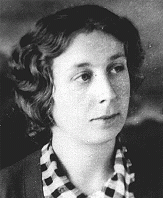
-
Monique Jackson
ID CardMonique's Jewish parents met in Paris. Her father had emigrated there from Russia to study engineering, and her mother had come from Poland as a young child. Monique's father did not have enough money to finish university, so he went to work as an upholsterer. He also shared a small business which sold his hand-tooled leather purses. 1933-39: Monique's mother was 20 when she gave birth to Monique in 1937. Two years later, Parisians were threatened by the possibility of bombing by the Germans, and French…

-
Nelly Adler
ID CardNelly was the youngest of three daughters born to Jewish parents in Liege, a French-speaking industrial city in eastern Belgium. Her Yiddish-speaking parents had moved there from Czechoslovakia a year before Nelly was born. The Adlers were one of only a few Jewish families in the largely Catholic city. Nelly grew up speaking French with her friends at school. 1933-39: The Adler's apartment was above a cafe and across the street from a Catholic church. Her parents ran a successful tailoring business from…
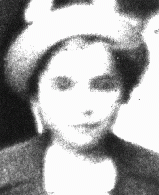
-
Sara Galperin
ID CardSara, born Sara Bernstein, was one of six children in a Jewish family in the Lithuanian village of Karchai. Her father was a farmer. Sara attended secondary school in Jonava and in 1920 she moved to Siauliai, where she met and married Pinchas Galperin. The couple owned and ran a dairy store, selling butter, milk and cheese. They had three children--two sons and a daughter. 1933-39: In addition to running the family store and rising early every morning to buy dairy products from the local farmers, Sara was…
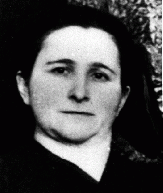
-
Rachela Rottenberg
ID CardThe younger of two children born to Jewish parents, Rachela grew up in Radom, an industrial town located some 60 miles south of Warsaw. One-quarter of the city's 100,000 prewar population was Jewish. Rachela's father was a Zionist and was active in municipal affairs. Her mother did volunteer work. l933-39: Germany invaded Poland on September 1, 1939. On September 5, with the Germans rapidly advancing, Rachela's family sought temporary safety with relatives in Warsaw. They got separated along the way.…

-
Jeno Gabor Braun
ID CardThe son of a rabbi, Jeno was raised in the town of Sighet in Transylvania. The region was multi-ethnic, and Jeno grew up in a family that knew Yiddish, Hungarian, Romanian, German and Hebrew. During World War I, when Sighet was near the front, Jeno's family fled to Hungary. There Jeno met Eszter Mendel, whom he married after the war. The couple settled in the town of Cristuru-Secuiesc in Romania. 1933-39: As a jeweler, Jeno is one of only two watchmakers in Cristuru-Secuiesc; the other is a German who…
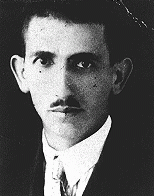
-
Robert Gruber
ID CardRobert was raised by Hungarian-speaking parents in Kosice, a town in eastern Slovakia with a sizable Jewish community of 7,000. The Grubers were a traditional Jewish family and they observed the Jewish Sabbath, dietary laws, and holidays. Robert's father owned a small jewelry shop. 1933-39: When Robert was 5, Kosice was taken over by the Hungarians, who were led by a dictator named Horthy. He stood on the main street with his parents, watching the soldiers march into town in a victory parade. They were…
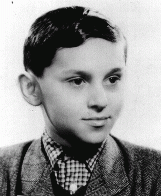
-
Bela Blau
ID CardBela's city of Bratislava, located on the banks of the Danube river, had an old and important Jewish community. Bela was the eighth child in his large Jewish family. His father was a furrier. At age 16 Bela began working as a salesman for a textile business. In 1930 he was called up for 18 months of army service. 1933-39: Bela and his wife moved to the Slovakian city of Zilina. Their son was born in November 1937. Bela worked for a German photographic company until 1938, when he lost his job because he…
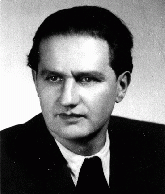
-
Pearl Harbor
ArticleJapan’s aerial attack on Pearl Harbor changed many Americans' attitudes toward involvement in WWII. Learn more about the events, facts, and background info.

-
Ruth Gabriele Silten
ID CardGabriele was the only child of Jewish parents living in the German capital of Berlin. Her grandfather owned a pharmacy and a pharmaceuticals factory, where Gabriele's father also made his living. 1933-39: In 1938 the Nazis forced Ruth's grandfather to sell his factory and pharmacy for very little money to an "Aryan" German. After that, her father decided they should move to Amsterdam where it was safer for Jews. She was 5 years old and wanted to stay in Berlin. She didn't understand why she had to leave…
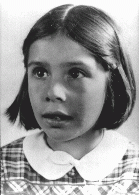
-
Ernst Silten
ID CardErnst was one of five sons born to a Jewish family in the Prussian city of Koenigsberg. He studied pharmacy and earned his doctorate in the late 1880s. Ernst spent several years as an apprentice before buying his own pharmacy in Berlin. Later, he also acquired a pharmaceuticals factory and supplied oxygen to hospitals. He married Marta Friedberg and the couple raised two sons. 1933-39: In Berlin, Ernst and his family lived in an apartment above their pharmacy and factory. In 1938 Ernst was forced to sell…

-
Erzsebet Markovics Katz
ID CardErzsebet was born to Jewish parents living in a town on the Bodrog River in northeastern Hungary. Sarospatak was a picturesque town with a ruined medieval fortress, the Windischgratz castle, and many wineries, flour mills, and brickworks. Erzsebet's father was a locksmith and sheet-metal worker. 1933-39: Erzsebet has married Jozsef Katz. It was a lovely, formal wedding. Jozsef comes from a large Jewish family. He's a joiner by trade and was working in Sarospatak when they met. Now they have moved here to…
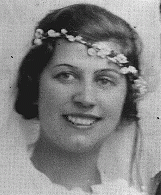
-
Itzik Rosenblat
ID CardItzik, also known as Izak, was one of three sons born to Yiddish-speaking Jewish parents. When Itzik was a young child his family moved to the city of Radom. Itzik left school when he was 11 to apprentice as a women's tailor. After he apprenticed with several tailors in Radom and Warsaw, he went back to school and earned a tailor's license. 1933-39: In 1938 Itzik married Taube Fishman, the daughter of his first employer, after a 13-year courtship much opposed by her family. They lived in Radom, where…

-
Atrocities against Burma's Rohingya Population
ArticleThe Burmese military has targeted the Rohingya people because of their ethnic and religious identity. The military’s actions constitute genocide and crimes against humanity. Learn more

-
Dismissal letter from the Berlin transit authority
DocumentA letter written by the Berlin transit authority (Berliner Verkehrs Aktiengesellschaft) to Viktor Stern, informing him of his dismissal from his post with their agency as of September 20, 1933. This action was taken to comply with provisions of the Law for the Restoration of the Professional Civil Service. On April 7, the German government issued the Law for the Restoration of the Professional Civil Service (Gesetz zur Wiederherstellung des Berufsbeamtentums), which excluded Jews and political opponents…

-
Sandor (Shony) Alex Braun describes how music gave him the strength to survive while imprisoned in concentration camps
Oral HistoryShony was born to religious Jewish parents in a small Transylvanian city. He began to learn the violin at age 5. His town was occupied by Hungary in 1940 and by Germany in 1944. In May 1944, he was deported to the Auschwitz camp in Poland. He was transferred to the Natzweiler camp system in France and then to Dachau, where he was liberated by US troops in April 1945. In 1950, he immigrated to the United States, and became a composer and a professional violinist.

-
Leopold Page describes meeting German industrialist Oskar Schindler
Oral HistoryLeopold was a teacher in Krakow, Poland, when World War II began in 1939. While serving in the Polish army, he was captured by Germans. Leopold escaped from a prisoner-of-war transport. Soon after, he met the German industrialist Oskar Schindler. The two became friends. Leopold was forced to live in the Krakow ghetto. He later worked in Schindler's factory in Bruennlitz. He and the other Jews who worked there were treated relatively well and protected from the Nazis. After the war, Leopold moved to the…

-
Sally Pitluk describes her removal from forced labor at Budy
Oral HistorySally Pitluk was born to Jewish parents in Płońsk, Poland in 1922. A few days after the German invasion of Poland in 1939, Płońsk was occupied. Sally and her family lived in a ghetto from 1940-1942. In October of 1942, Sally was transported to Auschwitz, where she was tattooed and moved into the subcamp Budy for forced labor. She stayed in the Auschwitz camp complex until the beginning of 1945 when she and other prisoners were death marched to several different camps. She was liberated in 1945 and…

-

-
Nazi Camps
ArticleNazi Germany and its allies established over 44,000 concentration camps and incarceration sites during the Holocaust. Read about the Nazi camp system.

-
Glossary of Terms and Individuals in the Nazi Judicial System
ArticleLearn more about the Holocaust Encyclopedia’s key terms and individuals in the Nazi judicial system.
-
Les Milles Camp
ArticleUnder the Vichy regime, the Les Milles camp held foreign Jews before emigration or, in most cases, deportation to German concentration camps and killing centers.

-
Gleichschaltung: Coordinating the Nazi State
ArticleGleichschaltung is the German term applied to the Nazification of all aspects of German society following the Nazi rise to power in 1933.
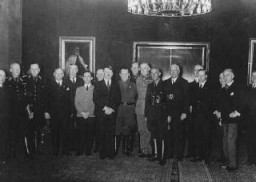
-
Earl G. Harrison: Biography
ArticleEarl G. Harrison, Commissioner for Immigration and Naturalization under FDR, is known for a report harshly criticizing the US and British treatment of Jewish DPs.

-
Grafeneck T4 Facility
ArticleThe Grafeneck T4 Center was the first centralized killing center to be established by German authorities within the context of the Nazi “euthanasia,” or T4, program.
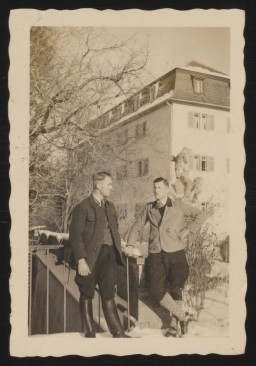
-
Polish hostages arrested during the "pacification" of Bydgoszcz
PhotoPolish hostages in the Old Market Square. Bydgoszcz, Poland, September 9–10, 1939. Just after the German invasion of Poland, armed groups of ethnic Germans in the city of Bydgoszcz staged an uprising against the local Polish garrison. This was put down by the next day, one day prior to the entrance of German troops in the city on September 5. A local command structure was quickly put into place by Major General Walter Braemer, and in response to continued attacks upon German personnel in the city,…

-
Law Limits Jews in Public Schools
Timeline EventApril 25, 1933. On this date, the German government issued the Law against Overcrowding in Schools and Universities, limiting the amount of Jewish students.
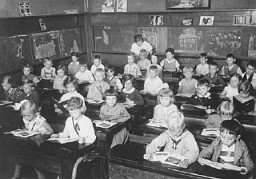
-
The British Policy of Appeasement toward Hitler and Nazi Germany
ArticleIn the 1930s, Prime Minister Neville Chamberlain and the British government pursued a policy of appeasement towards Nazi Germany to avoid war. Learn more.
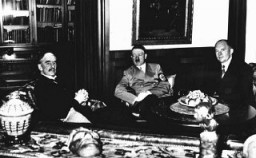
-
Nazi Territorial Aggression: The Anschluss
ArticleThe Anschluss, Germany's annexation of Austria in March 1938, was the Nazi German regime’s first act of territorial aggression and expansion. Learn more.
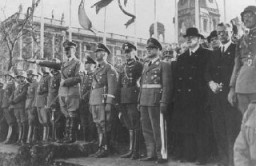
-
Mittelbau Main Camp: In Depth
ArticleLearn about conditions and forced labor in Dora-Mittelbau, the center of an extensive network of forced-labor camps for the production of V-2 missiles and other weapons.

-
Nesse Galperin Godin describes a roundup in the Siauliai ghetto
Oral HistoryNesse's family had a dairy business. The Germans occupied Lithuania in 1941 and established a ghetto in Siauliai. Nesse lived in the ghetto until 1943 when she was old enough to work. In 1944 Nesse, her mother, and a brother were deported to the Stutthof camp near Danzig. Nesse worked in several Stutthof subcamps until January 1945, when the inmates were put on a death march. She was liberated by the Soviets in March. Nesse, her mother, and two brothers survived, and she arrived in the United States in…

-
United States Immigration and Refugee Law, 1921–1980
ArticleUS immigration and refugee laws and policies evolved in response to World War I, the 1918 influenza pandemic, and World War II and the Holocaust. Learn more.
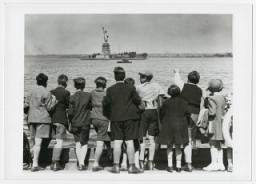
-
Fischel (Philip) Goldstein
ID CardFischel was the youngest of five children. He came from a Jewish family of artisans; his father was a tailor, his uncles were furriers, and his sister was a dressmaker. Fischel started his education at a Jewish parochial school at age 3, where he studied Hebrew and Yiddish. He continued his education at Jewish private schools until age 10, when he entered Polish public schools. 1933-39: After graduating from the Polish public school system at age 14, Fischel started an apprenticeship in his father's…

-
Esther Morgensztern
ID CardThe fourth of five children, Esther was born to Jewish parents living 35 miles east of Warsaw in the small predominantly Jewish town of Kaluszyn. Esther's mother and grandmother ran a newspaper kiosk in the town, and her father worked as a clerk at the town hall. 1933-39: Next year would have been Esther's last year at school, but she won't be able to graduate. War has broken out between Poland and Germany, so the schools have closed. A big battle took place here in Kaluszyn. The town was heavily shelled…
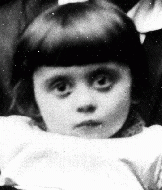
-
Alice Edelstein-Friedmann
ID CardAlice, born Alice Edelstein, was the youngest of two children raised in a Jewish family in the Bohemian village of Hostoun, near Prague. Shortly after Alice was born, her father moved the family to Vienna. There, Alice's father owned a wholesale shoe business. As a child, Alice attended public school and also received a religious education. 1933-39: After graduating from business school, Alice had a hard time finding a job because of the economic depression in Austria. In 1936 her father let her work in…
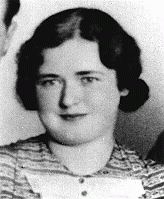
-
Jenine Gutman
ID CardJenine was the younger of two daughters born to Jewish parents. They lived in a small city with a large Jewish population in central Moldavia. Her father, a veteran of World War I, came from a large family and Jenine had more than 15 aunts and uncles, all living in Bacau. This extended family helped raise Jenine and her sister Sofia while their parents ran a grocery store. 1933-39: Just like every child her age, Jenine belonged to a national youth organization headed by Prince Michael. They wore special…
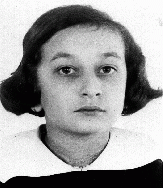
-
Max Gutmann
ID CardMax was raised in the Romanian town of Radauti, a trading and woodworking center near the Ukrainian border. The Gutmanns had a traditional Jewish home, and Max's father was on the board of directors of the local Jewish community. Max's father dealt in grain, feed, and livestock and he was a purveyor of horses for the Romanian military. 1933-39: Max's pony, Lisa, was kept in his family's stables with the other horses. The secondary school he attended was semi-private; it was governed by the state, but each…
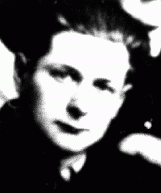
-
Zdenka Popper
ID CardZdenka was one of four children born to a Jewish family in Kolinec, a southwestern Bohemian town near the German border. Her father was a farmer and a lumber and grain merchant. Situated in the foothills of the Bohemian Forest, Kolinec was surrounded by rolling hills. Zdenka attended business school in the nearby town of Klatovy and, in 1927, moved to Prague with her uncle. 1933-39: Zdenka remembers how worried her mother was about the rise of German antisemitism in 1932. After listening to a radio…
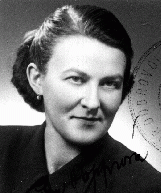
-
Helene Herta Katz Wohlfarth
ID CardHelene, called Herta, was born to a Russian-Jewish father and a German-Jewish mother in a town on the Main River, near Frankfurt. Her father had immigrated to Germany from Russia in 1890. Her mother had automatically taken on her husband's Russian citizenship when she married. In 1914 Russia and Germany went to war, and Russians living in Germany were considered "enemy aliens." 1933-39: Herta married Siegfried Wohlfarth in 1933 and could change from being "stateless" to taking on his German citizenship.…
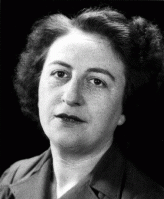
-
Dora Eiger
ID CardDora grew up in the industrial city of Radom, known for its armaments industry. Though fervently Jewish, her Yiddish-speaking parents differed from each other in that her mother was deeply religious while her father was not religious and was an ardent member of the Zionist Labor Party. Also known by her Jewish name D'vora, Dora attended Jewish schools and joined a Zionist youth organization. 1933-39: When Dora visited her uncle near the German border in 1936, she first noticed anti-Jewish placards and…
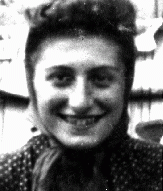
-
Nanny Gottschalk Lewin
ID CardNanny was the oldest of four children born to Jewish parents in the small town of Schlawe in northern Germany, where her father owned the town's grain mill. Nanny was given the Hebrew name Nocha. She grew up on the mill grounds in a house surrounded by orchards and a big garden. In 1911 Nanny married Arthur Lewin. Together, they raised two children, Ludwig and Ursula. 1933-39: Nanny and her widowed mother have moved to Berlin. They feared the rising antisemitism in Schlawe and hoped, as Jews, to be less…
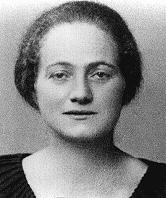
-
Lisl Winternitz
ID CardLisl was the youngest of two children born to a Jewish family in the Czechoslovakian capital of Prague, a city with a Jewish community that dated back to the eleventh century. Lisl's family lived on Karlova Street in the Karlin district of the city. Lisl's father owned a wholesale business that sold floor coverings. 1933-39: Lisl was 12 when, on March 15, 1939, the German occupation forces entered Prague. She went to school that day and a teacher shouted at her, "You dirty, filthy Jew," and then spat in…
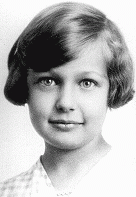
-
Rémy Dumoncel
ID CardRémy was born in a small French town to Catholic parents. In 1913, after studying law at the University of Paris, he joined the Tallandier publishing house in Paris. During World War I he served in the French army and was wounded five times. He returned to work at Tallandier after the war, and in 1919 he married Germaine Tallandier, the daughter of the owner. They had five children whom they raised as devout Catholics. 1933-39: In 1935 Rémy became the mayor of Avon, a small town about 35 miles southeast…

-
Henia Ring
ID CardThe youngest of two children, Henia was born to a Jewish family in the town of Krzepice. By the early 1930s, the Jewish population of Krzepice comprised more than 40 percent of the town's inhabitants. Henia's father made his living trading cattle in the area. Henia attended a public elementary school. 1933-39: On September 1, 1939, the Germans invaded Poland; a day later, they entered Henia's town. Her family tried to escape to Warsaw but the German forces quickly overtook them and ordered them back to…
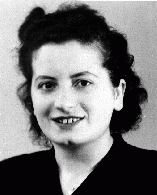
-
Kornelia Mahrer Deutsch
ID CardKornelia was known as Nelly. She was the older of two daughters raised by Jewish parents in the Hungarian capital of Budapest. Her father fought in the Hungarian army during World War I. Kornelia attended public school and later worked as a bookkeeper for a soap factory. In 1928 she married Miksa Deutsch, a businessman who sold matches. 1933-39: Kornelia's husband was religious and the Deutsches' three children attended Jewish schools. Miksa and his brother were the sole distributors in Hungary of…
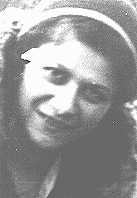
-
Berthold Mewes
ID CardBerthold was an only child. He was raised in Paderborn, a town in a largely Catholic region of western Germany. Paderborn was near Bad Lippspringe, where there was a Jehovah's Witnesses congregation engaged in missionary work. Beginning in 1933, the Nazis moved to outlaw Jehovah's Witness activities. 1933-39: When Berthold was 4, his parents became Jehovah's Witnesses and he began to attend secret Bible meetings with them. Berthold began public school in 1936. His mother was arrested in 1939 and sent to…
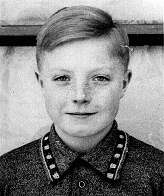
-
Carl Heumann
ID CardCarl was one of nine children born to Jewish parents living in a village near the Belgian border. When Carl was 26, he married Joanna Falkenstein and they settled down in a house across the street from his father's cattle farm. Carl ran a small general store on the first floor of their home. The couple had two daughters, Margot and Lore. 1933-39: Carl has moved his family to the city of Bielefeld, where he is working for a Jewish relief organization. Requests from this area's Jews to leave Germany have…
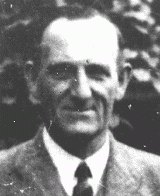
-
Fanny Judelowitz
ID CardFanny was the oldest of three girls born to a Jewish family in the Baltic seaport of Liepaja, a city with a large Jewish community in Latvia. Fanny attended a Jewish primary school there. Her parents owned and operated a shoe store and small shoe factory. 1933-39: As a young girl, Fanny's life revolved around activities with Betar, a Zionist youth movement founded in Riga in 1923. They had a group of about 25 boys and girls. They studied about Palestine and their Jewish heritage. In 1935 Fanny's mother…

-
Wilhelm Edelstein
ID CardWilhelm was the oldest of two children in a Jewish family living in the Habsburg capital of Vienna. Shortly after Wilhelm was born, World War I broke out. Because of food shortages, Wilhelm and his mother left for her hometown of Hostoun, near Prague. After the war they returned to Vienna where his father had remained to run his shoe business. As a young man, Wilhelm worked for his father. 1933-39: In March 1938 Germany annexed Austria. Soon after, the Germans arrested Wilhelm because he was a Jew dating…

